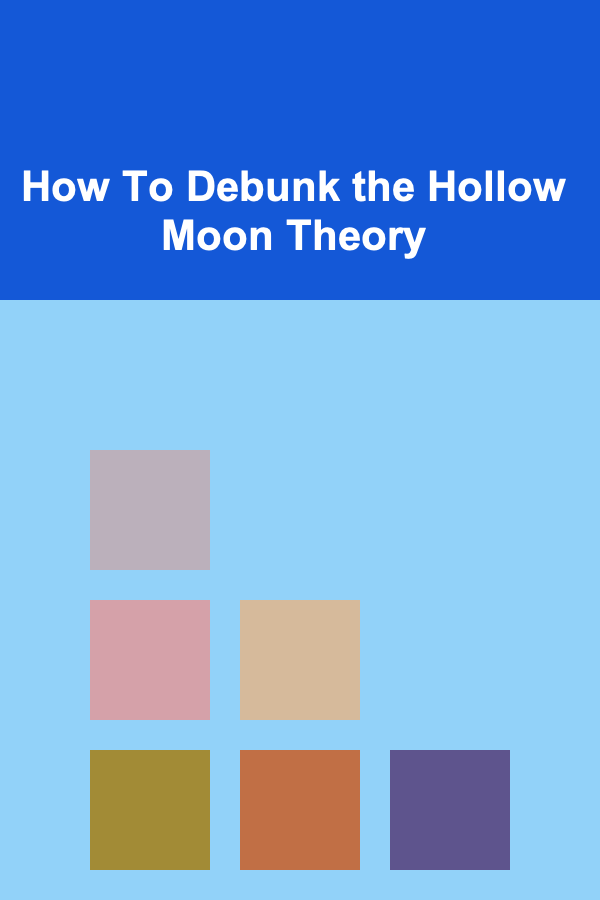
How To Debunk the Hollow Moon Theory
ebook include PDF & Audio bundle (Micro Guide)
$12.99$9.99
Limited Time Offer! Order within the next:

The Hollow Moon Theory is one of the many fringe ideas that have emerged over the years, challenging conventional scientific understanding of the Moon's nature and history. According to proponents of the theory, the Moon is not a solid celestial body but a hollow shell, possibly housing an advanced alien civilization. While such ideas may sound intriguing, they do not hold up under scientific scrutiny. In this article, we will explore how to debunk the Hollow Moon Theory by examining the evidence and offering a scientific perspective on the Moon's composition and history.
Understanding the Hollow Moon Theory
The Hollow Moon Theory suggests that the Moon is a hollow structure, often proposing that it was either artificially constructed or significantly altered by an alien civilization. There are several variations of the theory, ranging from the idea that the Moon is a vast, hollow sphere to the notion that its interior is filled with advanced technology or extraterrestrial beings.
Origins of the Theory
The origins of the Hollow Moon Theory can be traced back to the 1970s, when certain conspiracy theorists and pseudoscientific writers began speculating about the Moon's strange properties. These individuals pointed to a variety of anomalous observations, such as the Moon's perfect size relative to the Sun, the relatively low density of the Moon compared to the Earth, and the Moon's apparent lack of a magnetic field, as evidence for their claims.
One of the earliest and most influential proponents of the Hollow Moon Theory was the writer and conspiracy theorist Don Wilson. In his 1975 book Our Mysterious Moon, Wilson suggested that the Moon was an artificial satellite created by extraterrestrial beings. His theory was based largely on speculative interpretations of lunar data, including seismic activity and the Moon's surface features, which he claimed indicated that the Moon was not a natural object.
Popularity and Spread
The Hollow Moon Theory gained traction in the 1970s and 1980s, partly due to the increasing public interest in UFOs and extraterrestrial life. The theory was further fueled by claims that the Apollo missions, which took astronauts to the Moon in the 1960s and 1970s, had uncovered evidence of an alien presence on the Moon but were subsequently silenced by government agencies. Although no credible evidence was ever provided to support these claims, the idea of a hollow Moon continued to attract attention from conspiracy theorists and individuals skeptical of mainstream science.
The Scientific Understanding of the Moon
Before we delve into how to debunk the Hollow Moon Theory, it's important to first understand what we know about the Moon based on decades of scientific research and exploration. Our understanding of the Moon comes from a variety of sources, including telescopic observations, lunar rock samples brought back by the Apollo missions, and modern-day lunar probes.
The Moon's Formation
Current scientific consensus supports the Giant Impact Hypothesis as the most plausible explanation for the Moon's formation. According to this theory, the Moon formed approximately 4.5 billion years ago when a Mars-sized body, often referred to as Theia, collided with the young Earth. The debris from this collision eventually coalesced to form the Moon.
This impact hypothesis explains many features of the Moon, such as its composition, size, and the fact that it shares many similarities with Earth's outer layers. One of the key pieces of evidence supporting this theory comes from the analysis of lunar rocks returned by the Apollo missions, which show a composition that is very similar to that of Earth's mantle.
The Moon's Composition
The Moon's internal structure is believed to be composed of several layers. Like Earth, the Moon has a crust, mantle, and core, though its interior is much less differentiated than that of Earth. The Moon's crust is relatively thin, ranging from 30 to 40 kilometers in thickness, and is composed primarily of silicate rocks.
Beneath the crust lies the mantle, which makes up the majority of the Moon's volume. The mantle is made up of silicate minerals rich in iron and magnesium, and its density is similar to that of Earth's mantle, though it is much less active geologically. The Moon's core is small and contains a mix of iron and sulfur, but it is not thought to be large enough to generate significant magnetic fields.
Seismic Data and Lunar Interior
One of the most compelling pieces of evidence against the Hollow Moon Theory comes from seismic data gathered during the Apollo missions. In the late 1960s and early 1970s, NASA placed seismometers on the Moon's surface to measure lunar "moonquakes." These seismic waves provided scientists with valuable information about the Moon's internal structure.
The data from these experiments showed that the Moon has a layered interior, with a solid crust, mantle, and core. The seismic waves also revealed that the Moon's interior is far from hollow. In fact, some of the seismic waves traveled through the Moon's interior and returned to the surface, suggesting that the Moon has a dense interior structure rather than a hollow one. These findings directly contradict the Hollow Moon Theory and provide strong evidence for the Moon's solid nature.
The Moon's Density
One of the key arguments made by proponents of the Hollow Moon Theory is that the Moon's density is lower than that of Earth, suggesting that it might be hollow. However, this claim ignores the fact that the Moon's lower density is due to its composition rather than its structure.
The Moon is made primarily of silicate minerals, which are less dense than the metals that make up Earth's core. As a result, the Moon's overall density is about 3.34 grams per cubic centimeter, compared to Earth's average density of 5.52 grams per cubic centimeter. This difference in density is entirely consistent with the Moon's composition and does not suggest that the Moon is hollow.
In fact, the Moon's density is in line with what scientists would expect for a body with its size and composition. If the Moon were truly hollow, its density would be much lower, and we would expect to see significant differences in the way seismic waves propagate through its interior, which we do not.
Debunking the Hollow Moon Theory
Now that we have established a basic understanding of the Moon's composition and the scientific evidence supporting its solid nature, we can explore how to debunk the Hollow Moon Theory.
1. The Seismic Evidence
As mentioned earlier, the seismic data collected by the Apollo missions provides some of the most compelling evidence against the Hollow Moon Theory. The fact that seismic waves travel through the Moon and reflect off its interior layers indicates that the Moon is not hollow. If the Moon were hollow, seismic waves would not behave in the same way, and we would see drastically different results from the Apollo seismometers.
2. The Moon's Gravitational Field
Another important piece of evidence comes from the Moon's gravitational field. If the Moon were hollow, its gravitational field would be significantly weaker than what we observe. However, measurements taken by lunar probes, including the Lunar Reconnaissance Orbiter, show that the Moon's gravitational field is consistent with the presence of a solid, massive interior. This provides further evidence that the Moon is not hollow.
3. The Composition of Lunar Rocks
The analysis of lunar rocks returned by the Apollo missions has shown that the Moon's composition is similar to Earth's outer layers, with a high concentration of silicate minerals. These rocks contain elements such as oxygen, silicon, aluminum, and magnesium, which are consistent with a solid, rocky Moon. The idea that these rocks came from a hollow shell or artificial structure is highly implausible.
4. The Absence of Alien Structures
Proponents of the Hollow Moon Theory often claim that the Moon is hollow to make room for advanced alien technology or civilizations. However, there is no credible evidence to support this claim. The Apollo missions and subsequent lunar probes have not detected any structures or artificial features on the Moon's surface that would suggest the presence of an alien civilization. The Moon's surface is barren and lifeless, with no signs of technological activity.
5. The Moon's Orbital Behavior
The Moon's orbit around Earth is another key piece of evidence that debunks the Hollow Moon Theory. If the Moon were hollow, its mass would be distributed differently, and this would likely cause irregularities in its orbit. However, the Moon's orbit is stable and predictable, which is consistent with the presence of a solid, massive body.
6. The Lack of Magnetic Field
While it is true that the Moon does not have a global magnetic field, this does not support the idea that the Moon is hollow. The Moon's lack of a magnetic field is likely due to the absence of a molten core that could generate such a field, rather than an indication of a hollow interior. Additionally, other celestial bodies, such as Mars, also lack global magnetic fields despite being solid bodies.
Conclusion
The Hollow Moon Theory, though intriguing to some, is not supported by scientific evidence. From seismic data to gravitational measurements, the available evidence overwhelmingly points to the Moon being a solid body with a layered interior, similar to Earth. While fringe theories may continue to capture the imagination of conspiracy theorists, they do not hold up under the scrutiny of scientific inquiry.
By understanding the Moon's formation, composition, and behavior, we can confidently debunk the Hollow Moon Theory and appreciate the Moon for what it truly is: a fascinating, solid celestial body that has been shaped by billions of years of cosmic history.
Reading More From Our Other Websites
- [Home Storage Solution 101] How to Arrange Pots and Pans for Easy Access and Maximum Space Utilization
- [Personal Care Tips 101] How to Use Body Wash to Balance Your Skin's pH
- [Trail Running Tip 101] Mastering the Basics: Technique Tips for New Trail Runners
- [Polymer Clay Modeling Tip 101] From Figure Sculpting to Miniatures: Advanced Techniques for Mastering Sculpey
- [Home Budget Decorating 101] How to Make Your Own Decorative Pillows
- [Home Cleaning 101] How to Clean and Maintain Hardwood Floors for Long-Lasting Shine
- [Organization Tip 101] How to Organize Essential Oils for Travel
- [Home Lighting 101] How to Install Under-Cabinet Lighting for a Functional Kitchen or Bathroom
- [Sewing Tip 101] Quick Fixes: 5 Simple Hemming Techniques for Busy Professionals
- [Home Storage Solution 101] How to Incorporate Storage Solutions into Your Home Decor with Hidden Cabinets

How to Advertise Your Home Rental Property for Maximum Exposure
Read More
How to Build a Good Relationship with Your Tenants
Read More
How to Make Family Meetings Fun and Productive
Read More
How to Save Money on Laundry While Traveling
Read More
Understanding Customer Acquisition Cost (CAC) for Small Businesses
Read More
How to Repair a Broken Light Fixture
Read MoreOther Products

How to Advertise Your Home Rental Property for Maximum Exposure
Read More
How to Build a Good Relationship with Your Tenants
Read More
How to Make Family Meetings Fun and Productive
Read More
How to Save Money on Laundry While Traveling
Read More
Understanding Customer Acquisition Cost (CAC) for Small Businesses
Read More